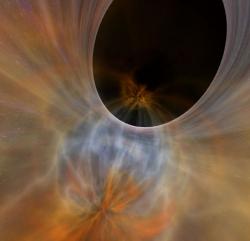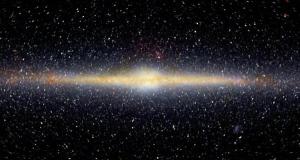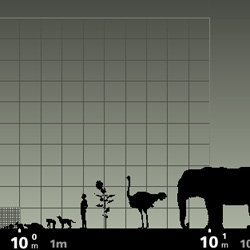Topic: Universe - on June 13, 2007 at 11:49:00 AM CEST
Maximizing Survival Time Inside the Event Horizon of a Black Hole
Here's a scenario that will face many of us in the far future. You're hurtling through the cosmos at nearly the speed of light in your spaceship when you take a wrong turn and pass into the event horizon of a black hole. Uh oh, you're dead - not yet, but it's inevitable. Since nothing, not even light can escape the pull from a black hole once it passes into the event horizon, what can you do to maximize your existence before you join the singularity as a smear of particles?

... Link (0 comments) ... Comment
Topic: Universe - on May 26, 2007 at 11:24:00 AM CEST
Cosmologists Predict A Static Universe In 3 Trillion Years
Now, physicists Lawrence Krauss from Case Western Reserve University and Robert J. Scherrer from Vanderbilt University predict that trillions of years into the future, the information that currently allows us to understand how the universe expands will have disappeared over the visible horizon. What remains will be "an island universe" made from the Milky Way and its nearby galactic Local Group neighbors in an overwhelmingly dark void.

... Link (0 comments) ... Comment
Topic: Universe - on May 9, 2007 at 11:55:00 AM CEST
Huge star explodes in brightest supernova yet seen
A gargantuan explosion ripped apart a star perhaps 150 times more massive than our sun in a relatively nearby galaxy in the most powerful and brightest supernova ever observed, astronomers said on Monday.
And there is one such star in our own Milky Way galaxy that appears to be on the brink of dying in just such a supernova.
The exploding star's dramatic death may have come in a rare type of supernova reserved for "freakishly massive" stars that astronomers had speculated about but never previously witnessed.

... Link (0 comments) ... Comment
Topic: Universe - on April 13, 2007 at 10:54:00 AM CEST
Water detected on distant planet
Water has been detected for the first time in the atmosphere of a planet outside our Solar System.
The planet, known as HD 209458b, is a Jupiter-like gas giant located 150 light-years from Earth in the constellation Pegasus.
... Link (0 comments) ... Comment
Topic: Universe - on March 31, 2007 at 1:43:00 PM CEST
Nikon's Universcale
gorgeous flash piece giving you a feel for how tiny or gigantic we are in the grand scheme of things... great use of silhouettes

... Link (0 comments) ... Comment
Topic: Universe - on March 1, 2007 at 5:35:00 PM CET
$60,000 to view the heavens
If you have a serious interest in astronomy and would not mind spending a precious chunk of your hard-earned money on garnering your interest further then this heavenly priced $60,000 Steady Stargazer from Meade is meant just for you! This robotic Max Mount RCX400 includes extensions that allow the scope to be remotely controlled from any web browser without software installation on the remote PC, MAC, PDA or even a cell phone. The telescope costs $40,000 and the mount alone is another $20,000.

... Link (0 comments) ... Comment
Topic: Universe - on February 16, 2007 at 1:32:00 PM CET
Hubble snaps death throes of sun-like star
Our sun will probably look very much the same for the next few billion years, plodding happily along the main sequence, bathing our solar system in its friendly yellow rays. All very nice for us living on Earth, of course, but not terribly exciting.

... Link (0 comments) ... Comment
Topic: Universe - on February 9, 2007 at 2:58:00 PM CET
Photo of 450 million light-years from Earth
This stunning group of galaxies is far, far away - about 450 million light-years from planet Earth - cataloged as galaxy cluster Abell S0740.
nasa.gov Observable universe [Wikipedia] The Hubble Deep Field: The Most Important Image Ever Taken [YouTube]
... Link (0 comments) ... Comment
Topic: Universe - on January 11, 2007 at 2:10:00 PM CET
Eavesdropping on the Universe
Astronomers have proposed an improved method of searching for intelligent extraterrestrial life using instruments like one now under construction in Australia. The Low Frequency Demonstrator (LFD) of the Mileura Wide-Field Array (MWA), a facility for radio astronomy, theoretically could detect Earth-like civilizations around any of the 1,000 nearest stars.

... Link (0 comments) ... Comment
Topic: Universe - on January 8, 2007 at 9:34:00 AM CET
Vast halo extends galaxy's size
Astronomers have found an enormous halo of stars around the Andromeda galaxy.
The discovery suggests the nearby spiral galaxy, also known as M31, is as much as five times bigger than astronomers had previously thought.
In fact, Andromeda's "suburbs" are so vast that they nearly overlap with those of our own Milky Way galaxy.
... Link (0 comments) ... Comment
Topic: Universe - on January 8, 2007 at 9:33:00 AM CET
The Universe within 1 billion Light Years
Galaxies and clusters of galaxies are not uniformly distributed in the Universe, instead they collect into vast clusters and sheets and walls of galaxies interspersed with large voids in which very few galaxies seem to exist. The map above shows many of these superclusters including the Virgo supercluster - the minor supercluster of which our galaxy is just a minor member. The entire map is approximately 7 percent of the diameter of the entire visible Universe.
... Link (0 comments) ... Comment
Topic: Universe - on November 1, 2004 at 8:51:00 AM CET
Planets Have Decided - Kerry Will Win
While surveys in the US are showing the presidential race to be closer than ever, top Indian astrologers are saying that the planets have already decided who is going to win the election - John Kerry.
... Link (0 comments) ... Comment










